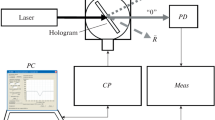Abstract
The relationship of the diffraction efficiencies of volume reflection holograms obtained with the use of double-beam and single-beam recording schemes in absorbing light-sensitive materials is studied theoretically and experimentally. This relationship is demonstrated by an example of a particular photopolymer material.
Similar content being viewed by others
References
S. N. Sharangovich and E. A. Dovolnov, “Models of Holographic Record of Reflection and Transmitted Diffraction Gratings in Optical Absorbent Photopolymeric Materials,” Proc. SPIE 5464, 399–410 (2004).
S. Gallego, M. Ortu˜no, C. Neipp, et al., “Maximum Effective Optical Thickness of the Gratings Recorded in Photopolymers,” Proc. SPIE 5827, 107–117 (2005).
V. V. Shelkovnikov, E. F. Pen, and V. I. Kovalevsky, “Optimal Optical Density of the Absorbing Holographic Materials,” Opt. Memory Neural Networks (Inform. Opt.) 16 (2), 75–83 (2007).
Yu. N. Denisyuk, “On the Reflection of Optical Properties of an Object in the Wave Field of the Radiation Scattered by it,” Optika Spektrosk. 15 (4), 522–532 (1963).
E. F. Pen, I. A. Zarubin, V. V. Shelkovnikov, and E. V. Vasil’ev, “Method for Determining the Shrinkage Parameters of Holographic Photopolymer Materials,” Avtometriya 52 (1), 60–69 (2016) [Optoelectron., Instrum. Data Process. 52 (1), 49–56 (2016)].
V. V. Shelkovnikov, E. V. Vasil’ev, V. V. Russkikh, et al., “Monochrome and Two-Color Holograms in Layered Photopolymer Materials,” Avtometriya 52 (4), 107–117 (2016) [Optoelectron., Instrum. Data Process. 52 (4), 404–412 (2016)].
H. Kogelnik, “Coupled Wave Theory for Thick Hologram Gratings,” Bell Syst. Techn. J. 48 (9), 2909–2947 (1969).
F.-K. Bruder, F. Deuber, T. Fäcke, et al., “Reaction-Diffusion Model Applied to High Resolution Bayfolr HX Photopolymer,” Proc. SPIE 7619, 76190I (2010).
V. V. Shelkovnikov, E. F. Pen, E. V. Vasil’ev, and P. E. Tverdokhleb, “Development of Holographic Photopolymer Materials and Methods for Studying Them,” in Proc. All-Russia Workshop “Yurii Nikolaevich Denisyuk as a founder of Russian holography,” Ioffe Institute of Physics and Technology, St. Petersburg, 2007, pp. 241–261.
H. S. Bagdasarian, Theory of Radical Polymerization (Nauka, Moscow, 1966) [in Russian].
S. A. Babin, E. V. Vasil’ev, V. I. Kovalevskii, et al., “Methods and Devices for Testing Holographic Photopolymer Materials,” Avtometriya 39 (2), 57–70 (2003).
E. F. Pen, “Device for Testing Light-Sensitive Holographic Materials,” Patent No. 165622 RF, Publ. 27.10.2016, Bul. No.30.
W. K. Smothers, B. M. Monroe, A. M. Weber, and D. E. Keys, “Photopolymers for Holography,” Proc. SPIE 1212, 20–29 (1990).
Author information
Authors and Affiliations
Corresponding author
Additional information
Original Russian Text © E.F. Pen, V.V. Shelkovnikov, 2018, published in Avtometriya, 2018, Vol. 54, No. 1, pp. 3–9.
About this article
Cite this article
Pen, E.F., Shelkovnikov, V.V. Comparison of the Diffraction Efficiency of Reflection Holographic Gratings for Different Recording Schemes in Photopolymer Materials. Optoelectron.Instrument.Proc. 54, 1–6 (2018). https://doi.org/10.3103/S8756699018010016
Received:
Published:
Issue Date:
DOI: https://doi.org/10.3103/S8756699018010016



